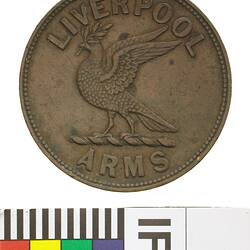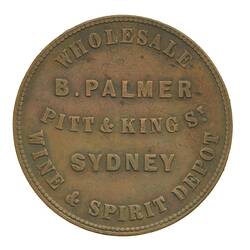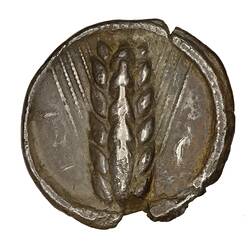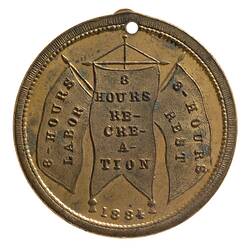Summary
Copper One Penny Token, minted by an unknown British mint. Issued by B. Palmer, Liverpool Arms, Sydney, circa 1857. Benjamin Palmer is listed as the publican of the Liverpool Arms Hotel between 1855 and 1867. B. Palmer was first listed as a publican in Ford's 1851 Directory at 'The Swan with Two Necks Tavern' on the corner of Park and George Streets South. In 1855 he was listed as the publican of the Liverpool Arms. Benjamin Palmer may have been a long serving alderman of Sydney (1870 to 1893), and Mayor of Sydney 1875-1876.
Previous Collections: George McArthur
Physical Description
A round bronze token (34 mm diameter). The token design features the name, address and business of the issuer: B. Palmer, Liverpool Arms, Pitt & King Street, Sydney, wine and spirit depot. The reverse features a representation of the mythical Liver bird, featured on early Arms of Liverpool. The Liver holds a sprig of olive in its beak (interpreted by Chitty as a 'liver weed', the sea-weed that proliferated in the estuary near Liverpool) and stands on a length of rope. This token has some spotting on the obverse.
Obverse Description
At centre, B.PALMER / PITT & KING ST. / SYDNEY; above, WHOLESALE; below, WINE & SPIRIT DEPOT
Reverse Description
A liver bird standing on rope facing left with wings spread and holding an olive branch in beak; around, LIVERPOOL ARMS
Edge Description
Plain
More Information
-
Collection Names
-
Collecting Areas
Numismatics & Philately, Sustainable Futures, Working Life & Trades
-
Acquisition Information
Transfer from National Gallery of Victoria (NGV), George McArthur, 15 Mar 1976
-
Date Issued
circa 1857 AD
-
Issued By
Benjamin Palmer - Liverpool Arms, Sydney, Greater Sydney, New South Wales, Australia, 1850-1868
-
Previous Collection
-
Inscriptions
Obverse: B.PALMER PITT & KING ST. SYDNEY WHOLESALE WINE & SPIRIT DEPOT Reverse: LIVERPOOL ARMS
-
Denomination
-
Series
-
Material
Copper
-
Axis
12
-
Classification
-
Category
-
Discipline
-
Type of item
-
Dimensions
34 mm (Outside Diameter), 14.745 g (Weight)
-
Shape
Round
-
References
The Liver Bird Another area of debate about the origins of the name Liverpool focuses upon the bird on the Liverpool seal. The name 'liver' is said to come from a type of waterfowl, named liver, or lever. The borough arms have been presented as proof of this but it has been suggested that no bird of that type has been found in the Liverpool area. The historian Sir J. A. Picton noted that the symbolic bird of Liverpool was the Eagle of St John, which meant that the name liver should not have been attributed to the bird. This theory is less certain due to the evidence presented by the town seal. By 1829 the seal featured an aquatic style, or water, bird which looked like a crane but the bird on the corporation seal (a copy of which is in Matthew Gregson's Fragments of the History of Lancashire) was not aquatic. The image on this seal is said to appear to be a dove with an olive branch, which had been made to look like seaweed. If this was the case, then the origin of the name was said to be topographical or related to the area itself. [Link 1]
[Thesis] Lugton, Mary E. 1989. George McArthur of Maldon: his Life and his Book Collection.
[Catalogue] Morrison, Ian. 2003. The Baker of Maldon.
[Book] Andrews, Arthur. 1921. Australasian Tokens and Coins., No. 408
[Book] Heyde, Gilbert C. & Skinner, Dion H. 1967. Unofficial Coins of Colonial Australia and New Zealand., No. 198
-
Keywords





